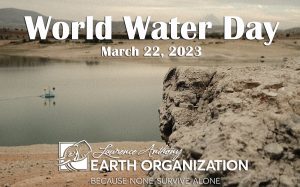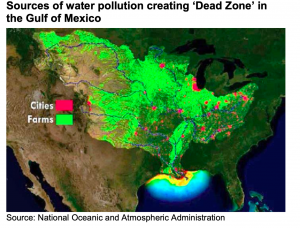In Observance of World Water Day March 22, 2023
By Diane Wagenbrenner-Stivey | March 21, 2023
Where there is mismanagement of fertile land and water, the shortsighted outcome is the creation of expanding deserts.
It is a sad fact that, depending on the region, 20-40% of the Earth’s previously fertile land has now been degraded to the point where it no longer supports life. This is a massively important statistic that not enough people and government officials are paying attention to or doing anything about.
Per the 2022 UN Global Land Outlook Report [1] “Humans have transformed more than 70% of Earth’s land area from its natural state causing unparalleled environmental degradation.”
The Earth Organization’s Technology Division recently investigated and discovered that American land degradation is getting the least amount of attention and investment, and yet, US lands are one of our most valuable resources and some of the most threatened and endangered assets we have. With this seemingly invisible negligence, the business of land acquisition and use threatens to collapse state and regional economies, communities, jobs, food, and water security across the nation. This is demonstrated as true by the fact that public-government and private investments in clean food and water are very small compared to other countries while we pour billions into funding weapons and security concerns offshore.
Of the total of 895 million farmland acres in the United States, only 1.5% of those lands are chemical or pollution free. Just last year, per the USDA, there were over 6,000 farms lost. The country’s small-town rural farming communities are vanishing and, sadly, being replaced by large scale, land-grab acquisitions that employ unsustainable land and water use practices.
So, what does all this have to do with World Water Day?
Large scale industrial agricultural inputs such as fertilizers, pesticides, herbicides (like cancer causing ‘Roundup’) are pollutants that flow into lakes, groundwater and down rivers and streams into our oceans. The Gulf of Mexico has enormous areas called “dead zones” because they are so polluted with these contaminants that it causes massive Red Tide outbreaks that make the water, sea life and people sick (due to overgrowth of algae causing oxygen depletion that kills all sea life.)[2]
The way that land and water is used and managed in the United States is reducing the health of people, oceans and ecosystems, all of which depend on CLEAN WATER.
Our investigations into this situation found there are simple and cost effective solutions for restoring our water and land, and transitioning farms from contaminators to regenerators is a vital necessity. In fact, a few years ago, we helped form AquaterreX , a water exploration company, and now partner with them on water and land restoration projects. A recent case study of a joint project in Texas demonstrates the workability of joining forces with business. With 126 million acres of farmland, Texas is well recognized for its state-of-the-art water management practices. However, our studies show the great state could stand some improvement and will have to implement more regenerative practices to conserve their water and soil assets to preserve their economy.
The Lawrence Anthony Earth Organization is building a Global Environmental Solutions Institute and LandSAVE® Alliance Network that will be entrusted to get the correct technologies applied to restore our groundwater resources and regenerate the over 100 million acres of America’s farmland by 2035. This will be a prosperity model that sets an example for the rest of the world.
Is water and land de-contamination and restoration worth investing in? Contrary to what you may have heard, yes, absolutely! In fact, according to numerous studies, returns from a regenerative restoration economy that reduces land degradation and biodiversity loss are estimated to be worth trillions, annually.
The United Nations Convention to Combat Desertification calculates this economy to be worth USD 125-140 trillion annually.
“As this Outlook’s restoration scenario analysis makes clear, business as usual is not a viable pathway for our continued survival and prosperity. As the global population grows, the increasing pressures to meet the rising demand for housing, food, and other essential goods are stretching the productive capacity of land and water systems to their limit. A rational response begins with a profound reassessment of current land use and management practices. Countries and communities can no longer rely on incremental reforms within traditional national planning and development frameworks. Priority must be given to creating the jobs and skillsets needed to fully realize the potential of a restoration economy – one that can respond to interlinked development and sustainability challenges.” Global Land Outlook 2 Report – https://www.unccd.int/resources/global-land-outlook/glo2
Factually, the best solutions are the simple solutions. The Earth Organization is committed to creating a new prosperity economy and believes it can restore and regenerate sane thinking and doing to restore and stabilize the health of our environment. This is all about moving back into alignment with natural laws by teaching and expanding our Cooperative Ecology™ training for the new generation of farmers, and land and water management professionals.
It can be done and it must be done for Earth’s water and food security for the health of all life!
Your health and the health of those you care about depend on having a clean, thriving world. Join our Cooperative Ecology Movement Today!
Sincerely,
Diane Stivey-Managing Director Operations
[1] https://www.unccd.int/resources/global-land-outlook/glo2
[2] https://oceantoday.noaa.gov/deadzonegulf/ – watch the video about dead zones.


